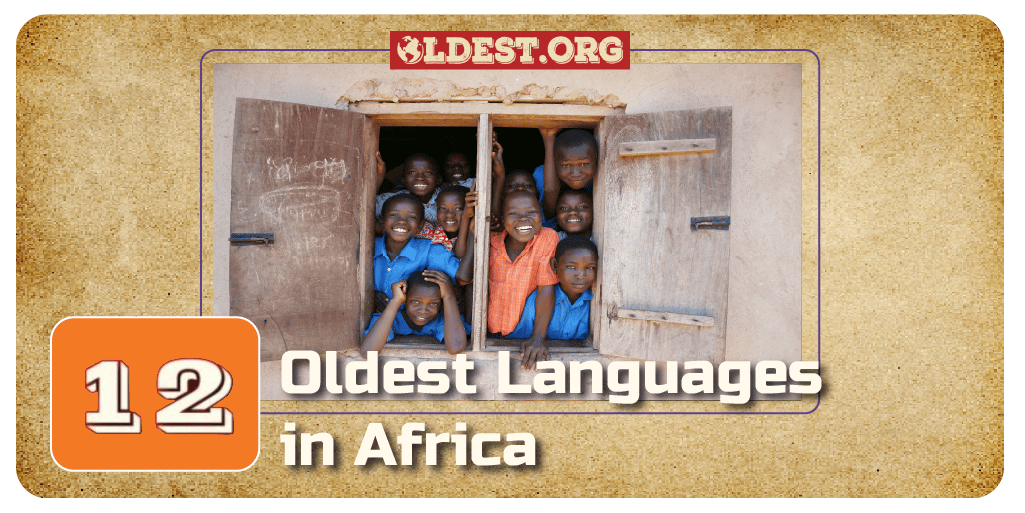Africa’s linguistic landscape is as diverse as it is ancient, with languages that have evolved over millennia, reflecting the continent’s rich history and cultural heritage.
From the click languages of the Khoisan group to the Afro-Asiatic languages of North Africa, these tongues offer a glimpse into Africa’s deep-rooted past and the development of human language.

In this article, we explore the 12 oldest languages in Africa, highlighting their origins, unique features, and cultural significance. Join us on a journey through Africa’s linguistic history, where each language shows the continent’s enduring legacy.
1. Khoisan Languages
Location: Southern Africa (primarily Botswana, Namibia, and South Africa)
Year: Estimated to have originated more than 25,000 years ago
The Khoisan languages are a group of languages known for their use of click consonants and are characterized by their unique phonetic sounds. They are spoken by various ethnic groups in Southern Africa, including the San and Khoekhoe people.
The Khoisan languages are known for their complex grammatical structures and are believed to have played a significant role in the development of other languages in the region.
Did You Know?
The Khoisan languages are considered to be among the oldest languages spoken by humans, with a history that predates many other language families in Africa.
2. Nilo-Saharan Languages
Location: Central and East Africa, including countries like Sudan, Chad, and Ethiopia
Year: Estimated to have originated around 8,000 to 10,000 years ago
The Nilo-Saharan language family is one of the largest language families in Africa, comprising over 200 languages. These languages are spoken by ethnic groups predominantly in the Nile Valley and the surrounding areas.
Examples of Nilo-Saharan languages include Dinka, Nuer, and Kanuri. These languages exhibit a variety of linguistic features, including complex phonetic systems and grammatical structures.
Did You Know?
The Nilo-Saharan language family is known for its linguistic diversity, with languages ranging from small, highly specialized languages spoken by hunter-gatherer communities to larger, more widely spoken languages like Dinka, which is spoken by millions of people in South Sudan.
3. Afro-Asiatic Languages
Location: North Africa and parts of the Horn of Africa
Year: Originated around 9,000 to 10,000 years ago
The Afro-Asiatic language family is one of the major language families in Africa, comprising around 300 languages spoken by approximately 350 million people. It includes languages like Arabic, Amharic, Hausa, and Oromo, among others.
These languages are diverse in structure and vocabulary, reflecting the rich cultural and historical background of the regions where they are spoken.
Afro-Asiatic languages have had significant influence and contact with other language families, leading to borrowings and linguistic adaptations over time.
Did You Know?
Arabic, a prominent Afro-Asiatic language, is not only the fifth most spoken language in the world but also one of the six official languages of the United Nations. It has a rich literary tradition, with classical Arabic being the language of the Quran and Islamic scholarship.
4. Niger-Congo Languages
Location: Sub-Saharan Africa (covering a vast region from Senegal to Kenya and down to South Africa)
Year: Originated around 5,000 to 6,000 years ago
The Niger-Congo language family is one of the largest language families in the world, comprising over 1,500 languages. It includes many of the languages spoken in sub-Saharan Africa, such as Swahili, Yoruba, Igbo, and Zulu.
These languages are known for their rich oral traditions, storytelling, and musical heritage. They also exhibit a wide range of phonetic and grammatical structures, making them linguistically diverse and fascinating to study.
Did You Know?
Swahili, a prominent Niger-Congo language, is the lingua franca of East Africa and is spoken by over 100 million people. It has borrowed extensively from Arabic due to historical interactions with Arab traders along the East African coast.
5. Austronesian Languages
Location: Primarily spoken in Madagascar, an island nation off the east coast of Africa
Year: Originated around 3,000 years ago
Austronesian languages belong to the Austronesian language family, which is one of the world’s largest language families. The most well-known Austronesian language in Africa is Malagasy, the national language of Madagascar.
Malagasy is unique as it has incorporated elements from Bantu, Arabic, English, French, and Hindi due to Madagascar’s history of trade and colonization.
Did You Know?
Malagasy is written in the Latin script, but it also has its own writing system called Sorabe, which is based on the Arabic script.
6. Khoekhoe Languages
Location: Southern Africa (primarily Namibia and parts of Botswana and South Africa)
Year: Originated more than 25,000 years ago
The Khoekhoe languages, also known as Khoekhoegowab, belong to the Khoe language family and are known for their use of click consonants and their unique phonetic sounds.
These languages were historically spoken by the Khoekhoe people, who were predominantly pastoralists and hunter-gatherers.
Did You Know?
The Khoekhoe languages have had a significant impact on the linguistic landscape of southern Africa and have contributed to the development of other languages in the region, including Afrikaans, which has borrowed extensively from Khoekhoe vocabulary and grammar.
7. Sandawe Language
Location: Tanzania (specifically the Kondoa District)
Year: Originated around 87,000 years ago
The Sandawe language is spoken by the Sandawe people, who are traditionally hunter-gatherers. It is a click language, known for its unique phonetic features and grammatical structure.
Sandawe is considered a language isolate, meaning it has no known relatives. Despite its small number of speakers, efforts are being made to preserve and promote the language and its cultural heritage.
Did You Know?
Linguists believe that the Sandawe language may provide insights into the prehistoric origins of human language due to its ancient roots and unique linguistic features.
8. Hadza Language
Location: The Hadza language is spoken by the Hadza people, primarily in Tanzania, around Lake Eyasi and the surrounding areas
Year: The Hadza language is estimated to have originated around 60,000 years ago, making it one of the oldest languages in Africa
Hadza is a language isolate, which means it has no known relatives. It is known for its unique phonetic features, including click consonants, which are rare in the world’s languages.
The language has a relatively small number of speakers, and its grammar and structure are of particular interest to linguists studying the evolution of human language.
Did You Know?
The Hadza language is not only one of the oldest languages in Africa but also one of the last remaining click languages on the continent.
The Hadza people are one of the last hunter-gatherer societies in East Africa, and their language reflects their unique way of life and deep connection to their environment.
9. Tuu Languages
Location: Primarily spoken in Southern Africa, specifically in Namibia and Botswana
Year: Originated more than 25,000 years ago
The Tuu languages, also known as Southern Khoisan, are known for their unique phonetic sounds, including the use of click consonants. The languages are characterized by their complex tonal system and rich oral traditions.
Despite their small speaker populations, the Tuu languages are considered important for their historical and cultural significance.
Did You Know?
The Tuu languages are believed to be some of the oldest languages still spoken today, providing valuable insights into the linguistic history of Southern Africa.
10. Cushitic Languages
Location: Eastern Africa (including countries like Ethiopia, Somalia, and Kenya)
Year: Originated around 6,000 to 8,000 years ago
The Cushitic languages are a branch of the Afro-Asiatic language family. They are spoken primarily in the Horn of Africa and parts of East Africa.
These languages are known for their complex grammatical structures, including rich morphology and extensive use of agglutination. The Cushitic languages have contributed to the cultural and linguistic diversity of the region.
Did You Know?
Some Cushitic languages, such as Somali, have a long history of written literature and poetry, showcasing the richness of their oral traditions.
11. Berber Languages
Location: North Africa (primarily Morocco, Algeria, Tunisia, and Libya)
Year: Originated around 3,000 years ago
The Berber languages, also known as the Amazigh languages, are a group of closely related languages spoken by the Berber people across North Africa. These languages have a long history and are believed to have originated from the Afro-Asiatic language family.
The Berber languages are known for their unique script, Tifinagh, which has ancient origins and is still used by some communities today.
Despite their rich cultural and historical significance, many Berber languages are considered endangered due to the dominance of Arabic and French in the region.
Did You Know?
The Berber languages have a rich oral tradition and are known for their poetic forms. They also have a strong influence on the local cultures and traditions of the Berber-speaking communities, including music, art, and folklore.
12. Bantu Languages
Location: Sub-Saharan Africa (covering a vast region from Cameroon to South Africa)
Year: Originated around 3,000 years ago
The Bantu languages are a group of over 500 closely related languages spoken by Bantu peoples throughout Africa. They are characterized by their noun class systems, which categorize nouns based on their characteristics, such as shape, size, and function.
Bantu languages are known for their extensive use of prefixes and suffixes to indicate grammatical relationships.
Did You Know?
Swahili, a Bantu language, is the most widely spoken language in Africa, with over 100 million speakers. It is also one of the official languages of the African Union.
Conclusion
The linguistic landscape of Africa is as diverse as its people and cultures. From the ancient click languages of the Khoisan to the rich oral traditions of the Berber languages, Africa’s languages reflect millennia of history and evolution.
As we celebrate this linguistic diversity, let us also recognize the importance of preserving and promoting these ancient languages for future generations to appreciate and learn from.











